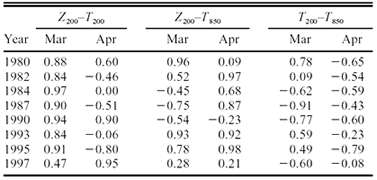
The lower-tropospheric heat budgets presented in the preceding section focused on how the warm years of the 1990s differed from the cool years of the 1980s, in an overall sense. But our results also show substantial interannual differences in the mean flow within each decade, even considering just the two subsets of years selected to illustrate decadal differences. Our limited objective is to examine the interannual variability in greater detail, in particular, the relationships between the mean structure of the stratosphere and lower troposphere. In essence, we seek to ascertain the degree to which different configurations of the flow resulted in similar lower-tropospheric conditions in the western Arctic during spring. This issue is addressed through compilation of spatial correlations between monthly mean anomalies in the lower stratosphere and lower troposphere. We have considered both the Arctic as a whole, that is, the entire polar region north of 70°N, and just the western Arctic, here defined as the sector north of 70°N, between 140°E and 90°W. The results for the two different regions are similar, and for the sake of brevity, we present the results for the western Arctic.
Spatial correlations are summarized in Table 2 between pairs of monthly mean anomaly distributions for March and April for the four years in the 1980s and in the 1990s selected in section 5. The first set of correlations is for geopotential height and temperature at 200 hPa. When these two parameters are positively correlated, geopotential height anomalies increase with height in the stratosphere. The strong positive correlations in 7 of 8 years in March, and in 3 of the 8 years in April suggest a well-developed stratospheric vortex in the Arctic in late winter/early spring, but the period this vortex persists into spring is quite variable.
TABLE 2. Spatial correlations between selected anomalies for geopotential height (Z) and temperature (T) for Mar and Apr.
The second and third sets of correlations in Table 2, which involve the 850-hPa temperature with the 200-hPa geopotential height and temperature, respectively, are used to indicate the consistency in the nature of the influence of the lower stratosphere on the lower-tropospheric temperature. The correlations between 850-hPa temperature anomalies and 200-hPa geopotential height anomalies provides an index of whether lower-tropospheric temperatures are reinforcing height anomalies aloft. The values shown in Table 2 indicate that 12 of the 16 months considered had 200-hPa height anomalies positively correlated with the 850-hPa temperature anomalies, but with considerable variability. We interpret this result to be a consequence of the vagaries in the weather in the western Arctic in spring. The subseasonal variability responsible for the bulk of the horizontal advection of heat is also liable to significantly impact the monthly mean temperature distributions and hence their relationships with the circulation aloft. It may not be a coincidence, therefore, that the two years in the 1990s with the strongest net horizontal advection of heat, 1993 and 1995, were also the two years with the strongest positive correlations between 200-hPa height and 850-hPa temperature anomalies.
The correlations between the temperature anomalies at the 200- and 850-hPa levels provide an indication of the direct radiative coupling between the lower stratosphere and lower troposphere. While the decadal averages presented earlier, and the trends documented by Angell (1999), show that the lower-stratospheric and lower-tropospheric temperature anomalies tend to be out of phase, the robustness of this relationship can be gauged by the spatial correlations between the temperature anomaly fields at 200 hPa and those at 850 hPa for individual months. These fields were negatively correlated in 12 of the 16 months investigated, and for these 12 months, 9 had correlations with magnitudes greater than 0.5. Three of the months did feature significant positive correlations between the temperatures at 200 and 850 hPa, and in each case it was during March. Our interpretation of this final set of correlations is that the springtime lower troposphere in the western Arctic is insensitive, at least directly, to the temperature anomalies and hence downwelling longwave radiation from the lower stratosphere because the effective optical depth is several kilometers. Again, the month-to-month fluctuations in this set of correlations are suspected to be a reflection of how the synoptic variability impacts the details in the circulation anomalies aloft and near the surface.
Our results are consistent with the idea that the principal low-frequency geopotential height anomalies in the Arctic occur in the stratosphere and they are also expressed below in the troposphere, but that tropospheric temperature anomalies result largely from anomalous horizontal temperature advection. The latter process is sensitive to the details in the distribution of the low-level winds and temperatures, which in turn are subject to midlatitude as well as to Arctic influences.
Return to previous section or go to next section